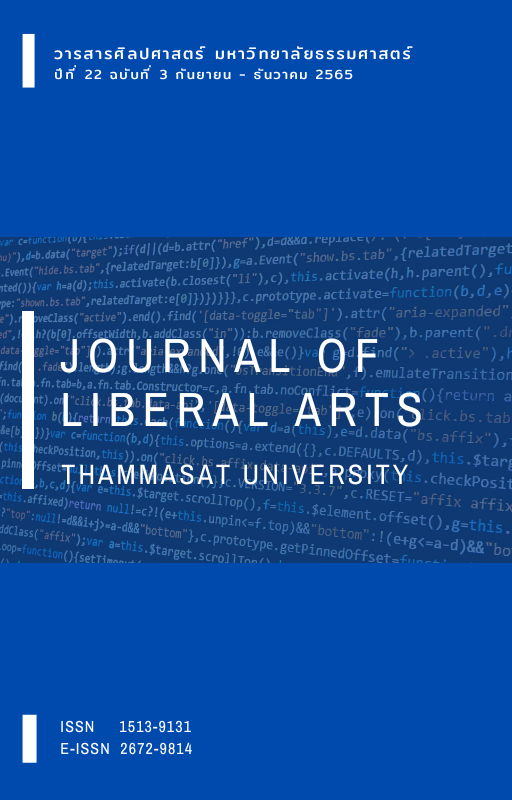ลักษณะการปนภาษาอังกฤษในภาษาไทยที่ใช้ในการสื่อสารของศูนย์บริหารสถานการณ์การแพร่ระบาดของโรคติดเชื้อไวรัสโคโรนา 2019 (ศบค.)
Main Article Content
บทคัดย่อ
จากการแพร่ระบาดของโรคอุบัติใหม่อย่างโรคติดเชื้อไวรัสโคโรนา 2019 ทำให้เกิดการปนของคำภาษาอังกฤษหรือการใช้ลักษณะของคำในภาษาอังกฤษเป็นจำนวนมาก ทั้งนี้เพื่อตอบสนองความจำเป็นในการสื่อสารในภาวะวิกฤตและสถานการณ์ที่ไม่เคยเกิดขึ้นมาก่อนในประเทศไทยและทั่วโลก จากการศึกษาหนังสือสั่งการของศูนย์บริหารสถานการณ์การแพร่ระบาดของโรคติดเชื้อไวรัสโคโรนา 2019 (ศบค.) ที่ปรากฏในเว็บไซต์ ศบค. ตั้งแต่ 1 เมษายน 2563 ถึง 31 มีนาคม 2565 รวมทั้งสิ้นจำนวน 608 ฉบับ พบรูปแบบเฉพาะของการปนภาษาอังกฤษในภาษาไทย โดยการปนภาษาอังกฤษในภาษาไทยพบรูปแบบที่สำคัญตามช่วงเวลา โดยในช่วงแรกของการระบาดของโรคนั้น การปนภาษาจะเกิดในลักษณะของการอธิบายโรค การดำเนินงานของภาครัฐซึ่งเปลี่ยนแปลงไปเป็นการทำงานทางไกลหรือออนไลน์ รวมถึงนโยบายการช่วยเหลือคนไทยที่อาศัยอยู่ต่างประเทศ หลังจากนั้นการปนภาษาจะพบมากในส่วนที่เกี่ยวข้องกับมาตรการการรักษาและการป้องกันโรค ส่วนในปัจจุบันนั้นมักจะพบการปนภาษาเมื่อมีการพูดถึงมาตรการควบคุมโรค ทั้งนี้การปนภาษาอังกฤษในภาษาไทยตลอดระยะเวลา 2 ปีที่ผ่านมาจะผ่านกระบวนการต่าง ๆ เช่น การแปล การทับศัพท์ การบัญญัติศัพท์ การใช้อักษรย่อภาษาอังกฤษ รวมไปถึงการผสมผสานกระบวนการต่าง ๆ เข้าไว้ด้วยกัน ผลจากการวิจัยสะท้อนให้เห็นถึงบทบาทที่สำคัญของภาษาอังกฤษในสังคมไทย นอกจากนี้ผลการวิจัยยังจะช่วยให้หน่วยงานภาครัฐสามารถวางแผนการสื่อสารที่มีประสิทธิภาพในภาวะวิกฤตที่อาจจะเกิดขึ้นในอนาคต
Downloads
Article Details

อนุญาตภายใต้เงื่อนไข Creative Commons Attribution-NonCommercial-NoDerivatives 4.0 International License.
เอกสารอ้างอิง
จุฑาทิพย์ จันทร์ลุน. (2563). พฤติกรรมสารสนเทศในยุคโควิด-19. วารสารห้องสมุดสมาคมห้องสมุดแห่งประเทศไทย, 64(2), 36-49.
ธวัช เวศตัน, และ ธนสิน ชุตินธรานนท์. (2564). ทำเนียบภาษาในการแถลงการณ์ของศูนย์บริหารสถานการณ์การแพร่ระบาดของโรคติดเชื้อไวรัสโคโรนา 2019 (ศบค.). วารสารวิชาการมนุษยศาสตร์และสังคมศาสตร์, 11(2), 13-25.
นันทนา วงษ์ไทย. (2564). การสร้างคำและความหมายของคำภาษาอังกฤษเกี่ยวกับสถานการณ์การแพร่ระบาดของเชื้อไวรัสโคโรนาสายพันธุ์ใหม่ 2019. วารสารมนุษยศาสตร์ปริทรรศน์, 43(2), 72-95.
ปรารถนา กาลเนาวกุล. (2544). การปนภาษาอังกฤษในภาษาไทยของรายการโทรทัศน์: ลักษณะ ทัศนคติ การรับรู้และแรงจูงใจ. คณะมนุษยศาสตร์และสังคมศาสตร์ วิทยาเขตปัตตานี มหาวิทยาลัยสงขลานครินทร์.
พรรณทิวา อินต๊ะ. (2555). การปนภาษาอังกฤษในนิตยสารภาษาไทย. พิฆเนศวร์สาร, 8(1), 33-42.
พรรณิดา ขันธพัทธ์. (2559). คำยืมภาษาต่างประเทศในภาษาไทใหญ่: กรณีภาษาอังกฤษ. วารสารวิชาการมนุษยศาสตร์และสังคมศาสตร์, 24(45), 159-175.
วิโรจน์ ศรีหิรัญ. (2564). นวัตกรรมวารสารศาสตร์เชิงสร้างสรรค์ในยุคดิจิทัลดิสรัปชั่นของสื่อมวลชนไทย. วารสารนิเทศศาสตรปริทัศน์, 25(1), 193-203.
ศิริพร บุตรเต, และ เพ็ญประภา สิงห์สวัสดิ์. (2562). การเปรียบเทียบคำยืมภาษาอังกฤษในพจนานุกรมฉบับราชบัณฑิตยสถาน พ.ศ. 2554 กับพจนานุกรมฉบับมติชน. วารสารมนุษย์กับสังคม คณะมนุษยศาสตร์และสังคมศาสตร์, 5(1), 101-123.
สรศักดิ์ เชี่ยวชาญ (2564). การใช้ภาษาในข่าวการแพร่ระบาดของโรคโควิด-19 จากเว็บไซต์หนังสือพิมพ์ออนไลน์. วารสารวิชาการคณะมนุษยศาสตร์และสังคมศาสตร์ มหาวิทยาลัยราชภัฏนครสวรรค์, 8(1), 72-89.
Bennui, P., & Hashim, A. (2014). English in Thailand: Development of English in a non-postcolonial context. Asian Englishes, 16(3), 209-228.
Foster, S. M., & Welsh, A. (2021). A ‘new normal’ of code-switching: Covid-19, the Indonesian media and language change. Indonesian Journal of Applied Linguistics, 11(1), 200-210.
Glass, T. (2009). Why Thais write to other Thais in English. World Englishes, 28(4), 532-543.
Jang, I. C., & Choi, L. J. (2020). Staying connected during COVID-19: The social and communicative role of an ethnic online community of Chinese international students in South Korea. Multilingua, 39(5), 541-552.
Kamluesai, R. (2017). An analysis of English loan words used in entertainment news in Thai daily newspaper [Unpublished master’s thesis]. University of Phayao.
Li, J., Xie, P., Ai, B., & Li, L. (2020). Multilingual communication experiences of international students during the COVID-19 Pandemic, Multilingua, 39(5), 529-539.
Piller, I., Zhang, J., & Li, J. (2020). Linguistic diversity in a time of crisis: Language challenges of the COVID-19 pandemic. Multilingua, 39(5), 503-515.
Snodin, N. S. (2014). English naming and code-mixing in Thai mass media. World Englishes, 33(1), 100-111.
Takashi, K. (1990). A sociolinguistic analysis of English borrowings in Japanese advertising texts. World Englishes, 9(3), 327-341.
Trakulkasemsuk, W. (2018). English in Thailand: Looking back to the past, at the present and towards the future. Asian Englishes, 20(2), 96-105.
Troyer, R. A. (2012). English in the Thai linguistic netscape. World Englishes, 31(1), 93-112.
Watkhaolarm, P. (2005). Think in Thai, write in English: Thainess in Thai English literature. World Englishes, 24(2), 145-158.
Zheng, Y. (2020). Mobilizing foreign language students for multilingual crisis translation in Shanghai. Multilingua, 39(5), 587-595.


